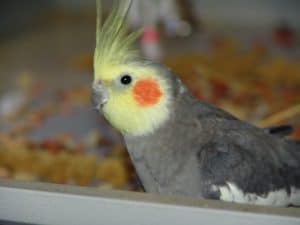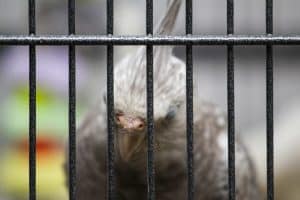Wondering about cockatiel habitat and where these friendly little birds originate from in the wild? Let’s take a look at where cockatiels are found in the wild and what their natural habitat looks like.
Basic Facts About Cockatiels
Scientifically known as Nymphicus hollandicus, cockatiels belong to the cockatoo family and are the only species within their own genus, Nymphicus. They are small birds, measuring about 12 inches in length, with distinct facial feathers, long tail feathers, and a unique crest on their heads. Male cockatiels have more vibrant colors, while female cockatiels have duller shades.
Cockatiels are social creatures that thrive in large flocks or small groups. They are known for their friendly and inquisitive nature, making them one of the most popular pet birds worldwide. Their life cycle is similar to other parrot species, with a breeding season that begins in the spring and lasts for about three weeks.
Where Do Wild Cockatiels Live?
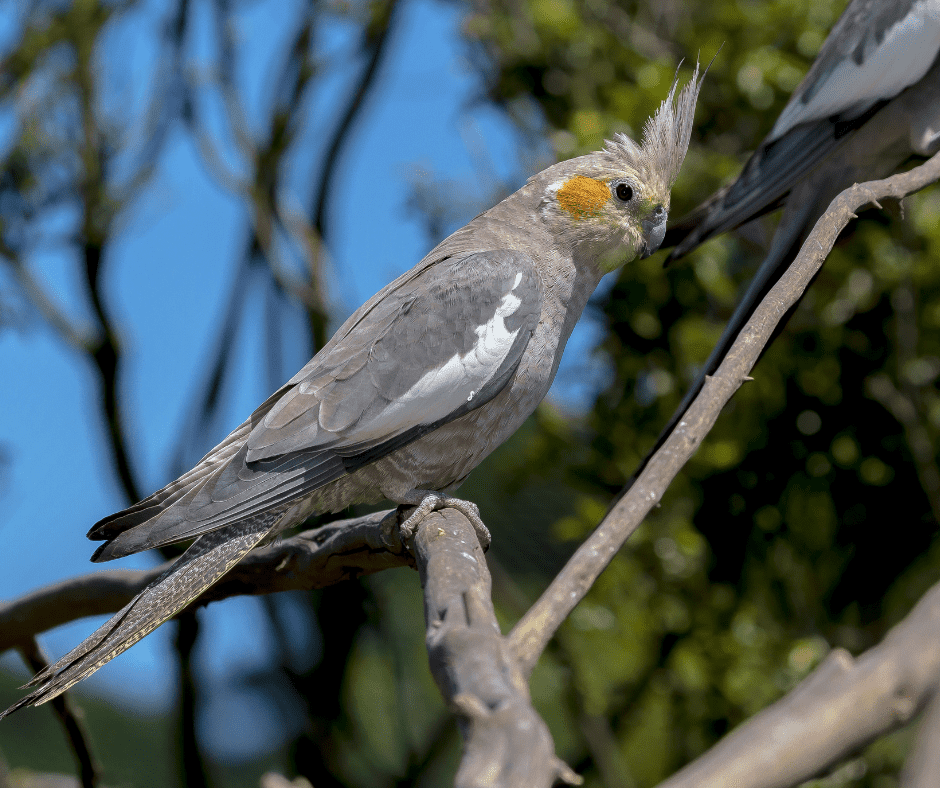
Cockatiels in the wild prefer to nest in tree hollows, which provide safety and shelter from predators and unfavorable weather conditions. During the breeding season, female cockatiels lay their eggs in the nest hollow and incubate them for about three weeks. Both male and female cockatiels take turns in guarding the nest and feeding their chicks.
How cockatiels have adapted to their environment?
The cockatiel has adapted to its environment in a few ways. One way the cockatiel has adapted is by relying on humans for food. Cockatiels are scavengers and will eat anything that is available to them. Because of this, they have learned to rely on humans for food. In areas where there is little human interaction, the cockatiel will search for food in trees or on the ground.
Another way the cockatiel has adapted is by developing a strong beak. The cockatiel’s beak is strong enough to break open cockatiel food sources such as nutshells, seeds, and fruits. The cockatiel’s beak is also sharp enough to pierce through the meat.
The cockatoo family has adapted in many ways to its environment. Parrots are able to fly long distances, which allows the flock to find food. They are also very intelligent birds that can learn to mimic sounds and human speech, which allows them to live with humans easily. The parrot family’s beak is also adapted for eating nuts and seeds, and for climbing trees.
What is the importance of preserving cockatiel’s natural habitat?
The cockatiel’s natural habitat is an important part of preserving the cockatiel. In the wild, cockatiels live in eucalyptus forests and low scrubs. They are able to survive in trees or on perches because they are strong enough to hold themselves up. The cockatiel has also adapted to its environment by developing a strong beak that is sharp enough to pierce through the meat.
The cockatiel’s natural habitat is also significant for humans. In the wild, cockatiels live in proximity to each other, which allows them to mate and produce offspring. When humans keep pet cockatiels, they are removing the bird from its natural habitat and prevent it from mating.
How you can help preserve the cockatiel habitat?

You can help preserve cockatiels’ natural habitat by planting trees in your backyard.
When you plant a tree, you are providing food and shelter for cockatiels. A tree hollow is a perfect place for a cockatiel to build a nest. When you plant a tree, you are also preserving the environment that cockatiels live in.
If you do not have a backyard, you can also help preserve cockatiels’ habitat by adopting or fostering an abandoned cockatiel. If the cockatiel is unable to find food and shelter in its natural habitat, it may seek food and shelter from humans.
What do cockatiels eat?
In addition to eating seeds, fruits, and vegetables, cockatiels also eat insects. Insects are a good source of protein, and they can be found in the wild in all types of habitats. Cockatiels will eat any type of insect that is available to them, including caterpillars, grasshoppers, spiders, and ants.
Feeding behavior
Cockatiels have a feeding behavior where they search for food in trees or on the ground. Cockatiel food sources include nuts, seeds, and fruits.
Male cockatiels
Male cockatiels are the dominant sex in the wild. They are usually the ones that lead the flock and are responsible for finding food and shelter for the group. In the wild, male cockatiels will mate with multiple females. To attract females, they will clean their feathers and preen.
Females cockatiels
Female cockatiels are the submissive sex in the wild. They will often follow behind the male birds and rely on them to find food and shelter for their group. As female cockatiels mature, they will become more aggressive than males because they are fighting for food or water.
Females incubate the eggs, feed the young, and keep the nest clean. They are also more aggressive during the mating season because they are searching for a mate. To attract males in the wild, female cockatiels will preen their feathers to make themselves appear bigger.
Breeding season

The breeding season for cockatiels in the wild is between September and November. During this time, male cockatiels will gather together to find a mate. Females will also gather together because they are searching for food and water. Cockatiels breed once a year because it takes them so long to raise their eggs and produce young.
After mating, females lay two or three eggs and incubate them for about 23 days. During the first few days of incubation, males will help to shade the eggs while they are waiting for the female to return. The male cockatiels will often stand over the nests and warm them with their wings during this time.
Cockatiel Breeders
There are many cockatiel breeders around the world who love these birds and are very passionate about breeding them. Cockatiel breeders typically keep their birds in large aviaries where the cockatiels can fly and nest freely.
The cockatiel is a popular bird for breeding because it is easy to breed and the chicks are relatively easy to raise. The chicks can be weaned at 6-8 weeks of age and will start to lay eggs at around 6 months of age.
Cockatiel breeders typically sell their birds to pet stores, bird breeders, and bird enthusiasts. If you are interested in purchasing a cockatiel, it is important to do your research and purchase your bird from a reputable breeder.
- STURDY CONSTRUCTION - Made of the highest-quality iron frame with a black powder varnish guaranteed to make this birdcage sturdy and durable, even against playful birds; With 4 caster wheels at the bottom, so you can move it anywhere you like, saving you effort
- MULTIPLE DOORWAYS - Designed with 2 doorways for your pet birds to enter and exit; The top of the cage opens up and can be propped open with a wooden crossbeam for your birds to stand on; Traditional doors are located on the side of the cage
- SLIDE-OUT TRAY - Equipped with a plastic tray at the bottom of this bird cage that can be removed for easy cleaning, so as to keep a clean and tidy environment as well as keep your pets safe
- VARIOUS WAYS TO PLAY - Includes a swing and multiple bars to stand on; Convenient doors so you can change the food without disturbing your pets; Locking joints to keep the cage secure; With little design features that stand out among the crowd
- EXTRA STORAGE SPACE - Comes with an additional mesh shelf so you can store food and toys out of the way; Provided with a wealth of accessories, including 4 Wooded perches, 4 Feeding cups, and 1 swing
Cockatiel behavior with other animals
Cockatiels can be kept as pets with other animals in the household. Some examples of common house pets that can live together with cockatiels are dogs, cats, rabbits, and guinea pigs.
They do not usually get into fights with these animals because they live on different rungs of the food chain. Dogs, cats, and guinea pigs are higher up on the food chain, while cockatiels and rabbits are lower on the food chain.
Cockatiels in captivity
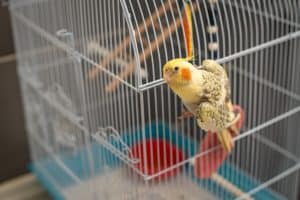
Cockatiels in captivity often become bored because they do not have anything to do. This can lead to the cockatiel biting its owner out of frustration. To prevent this, it is important to provide the cockatiel with plenty of toys and activities to keep it occupied. It is also significant to give the cockatiel plenty of food and fresh water.
The cockatiel is a popular pet among humans
The cockatiel is a very popular bird as a pet. They are easily trained and become attached and friendly with their owners. Cockatiels can also mimic human speech, which makes them desirable pets for many people. Even though they are domesticated, the cockatiel still needs to be able to build nests and fly.
How to take care of a pet cockatiel?
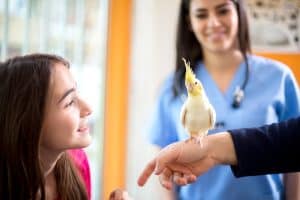
To make your pet cockatiel feel comfortable and happy, you need to feed him every day. If he is not hungry or his crop needs to be touched up with a bit more seed then give it until tomorrow morning before giving any food at all in case the bird has been sitting on one side of its cage while eating because this can cause them some discomfort when they sit down due to being positioned differently than how we are used to seeing them.
You also need to give your cockatiel fresh water every day as well as a cuttlebone or mineral block for him to gnaw on to help keep his beak healthy. The water dish should be cleaned out and refilled daily as well, just like his food dish. His cage should be cleaned out weekly and his perches and toys should be disinfected monthly.
The best way for owners who have several birds living together as well as those owning single-species households will want to keep an eye out towards making sure everyone gets their fair share, so no individual feels left behind!
When your pet cockatiel has health problems, it is important to take it to an avian veterinary clinic. Avian veterinarians are able to diagnose and treat any ailment that your pet might have. Another part of taking care of your pet cockatiels includes keeping them away from other pets in the household. Since they can become aggressive, birds should be kept in a separate area of the house.
How do you determine an individual’s sex?
Adult males of the rare wild cockatiels have gray feathers with a yellow face, orange patches on the cheeks, a long, wispy, gray, and yellow crest, and prominent white patches on gray wings. Female and juvenile cockatiels have duller plumage than adult males. The male’s tail is dark gray, but the female and juvenile usually have yellowish outermost tail feathers with gray barring. The male’s crest is orange-yellow on top, but females and juveniles have a dark gray crest cover, with only the tips of the feathers being yellow.
Summary: Cockatiel habitat
Cockatiels are one of the most popular pet birds. With so many people owning cockatiels, it is important to know what they need for their natural habitat.
There are many habitats for cockatiels, but the most common habitat is in trees or on perches. Cockatiels can be found throughout Australia and Indonesia because they have a natural ability to adapt to any environment that has enough food for them.


